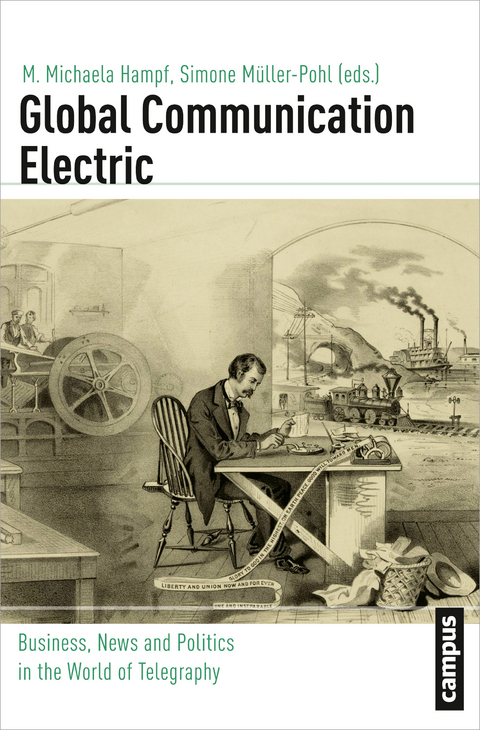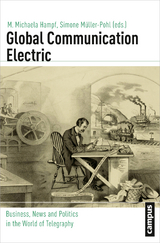Global Communication Electric
Michaela Hampf ist Juniorprofessorin am John-F.-Kennedy-Institut für Nordamerikastudien an der FU Berlin. Simone Müller-Pohl M.A. ist dort wissenschaftliche Mitarbeiterin.
Content
Global Communication Electric: Business, News and Politics in the World of Telegraphy
M. Michaela Hampf and Simone Müller-Pohl 7
Inter Nationalisms
Globalizing Telecommunications and Media History: Beyond Methodological Nationalism and the Struggle for Control Model of Communication History
Dwayne Winseck 35
Globalizing the Telegraph: The ITU and the Governance of the First Globalization of Telecommunications
Léonard Laborie 63
The Wiring of the Working Class: On the Interdependence of Telegraphy and Social-Revolutionary Discourses in the Nineteenth-Century
Martin Doll 92
Agents Actors
From Partnership to Confrontation: Japan and the Great Northern Telegraph Company, 1871-1943
Daqing Yang 117
Progress by Technology? The Utopian Linkage of Telegraphy and the World Fairs, 1851-1880
Lars Bluma 146
The "Manly Telegrapher": The Fashioning of a Gendered Company Culture in the Eastern and Associated Telegraph Companies
Wendy Gagen170
Use News
Telegraphy and the Emergence of an All-India Public Sphere
Michael Mann197
"All the News That's Fit to Print?" Reuter's Telegraphic News Service in Colonial India
Amelia Bonea223
Making the Wire Speak: Transnational Techniques of Journalism, 1860-1930
Volker Barth246
Space Time
Telecommunications Technology and News of Disaster: Earthquake Reporting in The Los Angeles Times, 1917-1939
Gordon Winder275
Northern Experiences of Global Telegraphy: Materiality and Technology in the Scandinavian Periphery
Jonas Harvard302
Power Lines: Arizona Elites, the Telegraph, and the Construction of a Regional Identity, 1870-1910
Torsten Kathke331
Between the Ends of a Wire: Electricity, Instantaneity and the Globe of Telegraphy
Florian Sprenger355
List of contributors382
On April 16, 1879 Emma Pender, wife of cable magnate and head of the Eastern and Associated Companies, John Pender, was having tea with her lady friends at her London house, when she received a package from her daughter in Fiji by the Melbourne steamer. Her daughter's letter accompanying the package was dated January 15, a good three months before the package interrupted Emma Pender's tea engagement. Her daughter asked Pender to send her a telegram to indicate how long the package had taken to arrive. While Emma Pender swiftly set her servant to this task, the package stirred a tea time discussion among the ladies present who all declared "the size of [their] world cruel." Pender later recalled in a letter to her daughter that it fell to the hostess to remind her excited guests of "older days" without the telegraph and "no regular mail at all." For Victorian upper class women, telegraphy and the global communications system swiftly became integral parts of their everyday lives. Indeed, Pender's interaction with her daughter was embedded in a world-wide system of regular mail and parcel service, railway and steamship transportation and messenger boys as well as telegraphy. The size of the world might have seemed cruel to ladies enjoying high tea in Victorian London, but the global communciations system had enabled them to idealize an electric world in union in the first place.
Telegraphs are an emblem of modernity as well as catalysts of our present global condition. The establishment of an extensive and world-spanning network of landline and submarine cable connections in the mid-nineteenth century fostered the emergence of structures and patterns of interaction on a global scale. World politics, a global economy and a global media system only became possible with the creation of global communication electric. Moreover, the telegraphs caused the most dramatic globalization effects among all new technologies of the nineteenth century, as telegraph lines were easier to lay than railway tracks and transmitted news with a higher speed and greater capacity than steamships. Significant changes in long-distance communication occurred particularly after the successful completion of the transatlantic telegraph cable in 1866 and the subsequent expansion of land and submarine lines to cross the Euro-American continents and establish connections from Europe and North America to India, Australia, Japan and Brazil in the 1870s. Message and messenger became more independent of each other as the former could now travel faster than the latter. Communication over large distances became telecommunication - the focus of modern media culture changed from a movement of goods to a transmission of information. This had enormous effects: news not only travelled ever faster, it also became ever more current - albeit not necessarily more newsworthy. Despite exorbitant transmission rates, increasing numbers of people used the telegraphs for political, economic and, to a lesser extent, private communication. Starting out with a few hundred telegrams per year passing through this global network, numbers rose to six million telegrams a year by the turn of the twentieth century. By 1900, much of the world had 'logged on' to global communication electric.
"The universe is a procession, with measured and beautiful motion," wrote Walt Whitman in "I Sing the Body Electric," an 1855 poem that explored how the human body mediates between the spiritual and the material world. Whitman's body electric combines poetic discoveries and aesthetic manifestos with the physical body, portraying the soul as inseparable from its corporeal manifestation. So too contemporaries saw the world as a body with nerves of submarine and telegraph cables that spanned its circumference. Like Whitman's body electric, telegraph cables seemed to offer a new means to understand the soul of the world and to offer a connection that promised universal peace and harmony akin to a body in p
| Erscheint lt. Verlag | 2.10.2013 |
|---|---|
| Reihe/Serie | Globalgeschichte ; 15 |
| Co-Autor | Volker Barth, Lars Bluma, Amelia Bonea, Martin Doll, Wendy Gagen, Graeme Gooday, Jonas Harvard, Torsten Kathke, Leonard Laborie, Michael Mann, Florian Sprenger, Gordon Winder, Dwayne Winseck, Daqing Yang |
| Zusatzinfo | div. Abbildungen |
| Verlagsort | Frankfurt |
| Sprache | englisch |
| Maße | 141 x 214 mm |
| Gewicht | 480 g |
| Themenwelt | Geschichte ► Allgemeine Geschichte ► Neuzeit (bis 1918) |
| Geschichte ► Teilgebiete der Geschichte ► Technikgeschichte | |
| Technik | |
| Schlagworte | 19. Jahrhundert • 20. Jahrhundert • Afrika • Amerika • Asien • Australien • Europa • Globalgeschichte • Kommunikation • Moderne • Technologie • Telegraf • Telegrafie • Telegraph • Telegraphie • Welt |
| ISBN-10 | 3-593-39953-9 / 3593399539 |
| ISBN-13 | 978-3-593-39953-9 / 9783593399539 |
| Zustand | Neuware |
| Haben Sie eine Frage zum Produkt? |
aus dem Bereich




